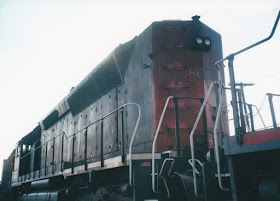I took these pictures in August of 2000. First, at Union Pacific's Albina Yard in Portland, Oregon, is Union Pacific #9408, a 4,135-horsepower Dash 8-41CW that was built by General Electric in November 1990.
Here is a trio of Union Pacific 2,000-horsepower GP38-2s, which all have different histories. On the right is Union Pacific #2022, which was built new for Union Pacific by the Electro-Motive Division of General Motors in April 1974. On the left is Union Pacific #2171, which was built by the Electro-Motive Division of General Motors in January 1980 as Missouri Pacific #2171. After the Missouri Pacific was merged into the Southern Pacific in 1982, this locomotive became Union Pacific #2171 on October 8, 1993. Finally, in the center is Union Pacific #2530, which has a more complicated history that deserves a closer look.
Union Pacific #2530 was originally built by the Electro-Motive Division of General Motors in January 1966 as Illinois Central #3026, a 3,000-horsepower GP40 without dynamic brakes. On August 10, 1972, the Illinois Central merged with the Gulf, Mobile & Ohio to form the Illinois Central Gulf, and this locomotive became Illinois Central Gulf #3026. After being retired by ICG, the locomotive was acquired by Helm Financial Corporation, reconditioned with dynamic brakes added, and leased to Union Pacific, becoming Union Pacific #853 on May 26, 1989. In 1998 it was returned to Helm Financial, was rebuilt by Boise Locomotive Company of Boise, Idaho, into a 2,000-horsepower GP38-2, and again leased to Union Pacific, becoming Union Pacific #2530 on August 20, 1998. When it was rebuilt from a GP40 to a GP38-2, its turbocharger was removed and an air filter box was installed in front of the dynamic brake housing, but it otherwise still resembles a pre-Dash 2 GP40, with three radiator fans, no water level sight glass below the radiators, and no shock absorbers on the trucks.
Leading a northbound freight train fast the Amtrak depot in Vancouver, Washington, is Burlington Northern Santa Fe #2880, a GP39M that was originally built by the Electro-Motive Division of General Motors in December 1964 as Cotton Belt (St. Louis Southwestern) #767, a 2,500-horsepower GP35. After 1965 it was renumbered to Cotton Belt #6507. Retired on April 15, 1987, it was sold on August 16, 1988 to Wilson Rail Services, then resold later that month to Morrison-Knudsen of Boise, Idaho, who rebuilt it into 2,300-horsepower GP39M Burlington Northern #2880 on February 10, 1989. Following the merger of the Burlington Northern and the Atchison, Topeka & Santa Fe on September 22, 1995, this locomotive became Burlington Northern Santa Fe #2880 and was repainted into Burlington Northern Santa Fe's "Heritage I" paint scheme on May 9, 2000, and had its headlight lowered into the nose following Santa Fe practice.
Southern Pacific #8165 is a 4,380-horsepower Dash 9-44CW that was built by General Electric in October 1994.
Spliced between a Burlington Northern Santa Fe Dash 9-44CW and a former Atchison, Topeka & Santa Fe (now BNSF) SD45-2 are Burlington Northern #6845 & #8153, 3,000-horsepower SD40-2s that were built by the Electro-Motive Division of General Motors in July 1978 and July 1980, respectively. Burlington Northern #6845 was built as St. Louis-San Francisco (SLSF, also known as the Frisco) #955. The Frisco was merged into the Burlington Northern on November 21, 1980, and the locomotive became Burlington Northern #6845.
Leading a freight train from Portland to head east up the Columbia River Gorge, Burlington Northern Santa Fe #8022 is a 3,000-horsepower SD40-2 that was built by the Electro-Motive Division of General Motors in March 1978. Following the merger of the Burlington Northern and the Atchison, Topeka & Santa Fe on September 22, 1995, this locomotive became Burlington Northern Santa Fe #8022 and was repainted into Burlington Northern Santa Fe's "Heritage I" paint scheme on December 21, 1998, and had its headlight lowered into the nose following Santa Fe practice.
The trailing unit in the freight train, Burlington Northern #7278 is a 3,000-horsepower SD40-2 that was built by the Electro-Motive Division of General Motors in March 1980.


























































